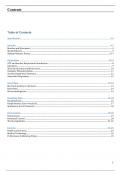Summary
Summary Edexcel Biology A Level (Salters Nuffield A) Topic 7 - Run for your Life - Full Notes
- Course
- Institution
Detailed and comprehensive notes on topic 7 (run for your life) of Edexcel biology A Level. Covers (skeletal) muscle, sliding filament theory, aerobic respiration, anaerobic respiration, heart rate, electrical activity in the heart, breathing, spirometry, homeostasis, thermoregulation, exercise, me...
[Show more]



